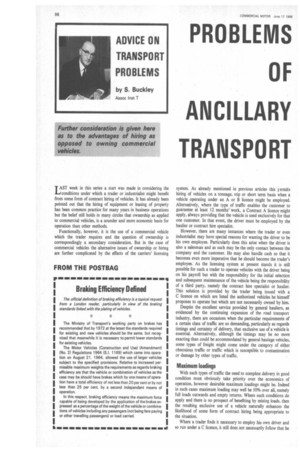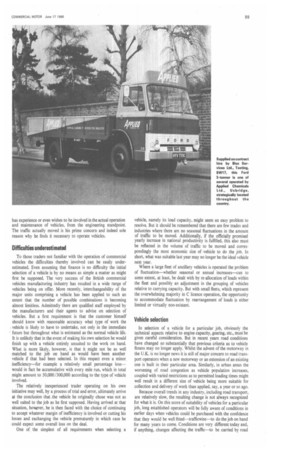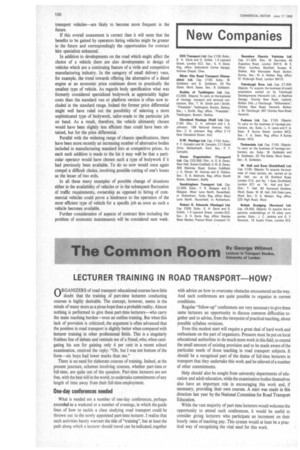PROBLEMS OF ANCILLARY TRANSPORT
Page 100

Page 101

Page 102

If you've noticed an error in this article please click here to report it so we can fix it.
y AST week in this series a start was made in considering the La conditions under which a trader or industrialist might benefit from some form of contract hiring of vehicles. It has already been pointed out that the hiring of equipment or leasing of property has been common practice for many years in business operations but the belief still holds in many circles that ownership as applied to commercial vehicles, is a sounder and more economic basis for operation than other methods.
Functionally, however, it is the use of a commercial vehicle which the trader requires and the question of ownership is correspondingly a secondary consideration. But in the case of commercial vehicles the alternative issues of' ownership or hiring are further complicated by the effects of the carriers' licensing system. As already mentioned in previous articles this rermits hiring of vehicles on a tonnage, trip or short term basis when a vehicle operating under an A or B licence might be employed. Alternatively, where the type of traffic enables the customer to guarantee at least 12 months' work, a Contract A licence might apply, always providing that the vehicle is used exclusively for that one customer. In that event, the driver must be employed by the haulier or contract hire specialist.
However, there are many instances where the trader or even industrialist may have special reasons for wanting the driver to be his own employee. Particularly does this arise when the driver is also a salesman and as such may be the only contact between the company and the customer. He may also handle cash so that it becomes even more imperative that he should become the trader's employee. As the licensing system at present stands it is still possible for such a trader to operate vehicles with the driver being on his payroll but with the responsibility for the initial selection and subsequent maintenance of the vehicle being the responsibility of a third party, namely the contract hire specialist or haulier. This solution is provided by the trader being issued with a C licence on which are listed the authorized vehicles he himself proposes to operate but which are not necessarily owned by him.
Despite the excellent service provided by general hauliers, as evidenced by the continuing expansion of the road transport industry, there are occasions when the particular requirements of a certain class of traffic are so demanding, particularly as regards timings and certainty of delivery, that exclusive use of a vehicle is essential. Alternatively, although the timings may be no more exacting than could be accommodated by general haulage vehicles, some types of freight might come under the category of either obnoxious traffic or traffic which is susceptible to contamination or damage by other types of traffic.
Maximum loadings With such types of traffic the need to complete delivery in good condition must obviously take priority over the economics of operation, however desirable maximum loadings might be. Indeed in such cases maximum loading may well be 50% over all, namely full loads outwards and empty returns. Where such conditions do apply and there is no prospect of benefiting by mixing loads, then the resulting exclusive use of a vehicle naturally enhances the likelihood of some form of contract hiring being appropriate to the situation.
Where a trader finds it necessary to employ his own driver and so run under a C licence, it still does not necessarily follow that he has experience or even wishes to be involved in the actual operation and maintenance of vehicles, from the engineering standpoint. The traffic actually moved is his prime concern and indeed sole reason why he finds it necessary to operate vehicles.
Difficulties underestimated
To those traders not familiar with the operation of commercial vehicles the difficulties thereby involved can be easily underestimated. Even assuming that finance is no difficulty the initial selection of a vehicle is by no means as simple a matter as might first be supposed. The very success of the British commercial vehicles manufacturing industry has resulted in a wide range of vehicles being on offer. More recently, interchangeability of the major units comprising a vehicle has been applied to such an extent that the number of possible combinations is becoming almost limitless. Admittedly there are qualified staff employed by the manufacturers and their agents to advise on selection of vehicles. But a first requirement is that the customer himself should know with reasonable accuracy what type of work the • vehicle is likely to have to undertake, not only in the immediate ' future but throughout what is estimated as the normal vehicle life. It is unlikely that in the event of making his own selection he would finish up with a vehicle entirely unsuited to the work on hand. What is more likely, however, is that it might not be as well matched to the job on hand as would have been another vehicle if that had been selected. In this respect even a minor, inefficiency—for example a relatively small percentage loss— would in fact be accumulative with every mile run, which in total might amount to 50,000/300,000 according to the type of vehicle involved.
The relatively inexperienced trader operating on his own initiative may well, by a process of trial and error, ultimately arrive at the conclusion that the vehicle he originally chose was not as well suited to the job as he first supposed. Having arrived at that situation, however, he is then faced with the choice of continuing to accept whatever margin of inefficiency is involved or cutting his losses and exchanging the vehicle prematurely in which case he could expect some overall loss on the deal.
One of the simplest of all requirements when selecting a vehicle, namely its load capacity, might seem an easy problem to resolve. But it should be remembered that there are few trades and industries where there are no seasonal fluctuations in the amount of traffic to be moved. Additionally, if the officially promised yearly increase in national productivity is fulfilled, this also must be reflected in the volume of traffic to be moved and correspondingly the most economic size of vehicle to do the job. In short, what was suitable last year may no longer be the ideal vehicle next year.
Where a large fleet of ancillary vehicles is operated the problem of fluctuation—whether seasonal or annual increases—can to some extent, at least, be dealt with by re-allocation of loads within the fleet and possibly an adjustment in the grouping of vehicles relative to carrying capacity. But with small fleets, which represent the overwhelming majority in C licence operation, the opportunity to accommodate fluctuation by rearrangement of loads is either limited or virtually non-existent.
Vehicle selection
In selection of a vehicle for a particular job, obviously the technical aspects relative to engine capacity, gearing, etc., must be given careful consideration. But in recent years road conditions have changed so substantially that previous criteria as to vehicle fitness may no longer apply. Whilst the advent of the motorway in the U.K. is no longer news it is still of major concern to road transport operators when a new motorway or an extension of an existing one is built in their particular area. Similarly, in urban areas the worsening of road congestion as vehicle population increases, coupled with varied restrictions as to permitted loading times might well result in a different size of vehicle being more suitable for collection and delivery of work than applied, say, a year or so ago.
Because overall trends in any industry, including road transport, are relatively slow, the resulting change is not always recognized for what it is. On this score of suitability of vehicles for a particular job, long established operators will be fully aware of conditions in earlier days when vehicles could be purchased with the confidence that they would be well fitted—trafficwise--to do the job on hand for many years to come_ Conditions are very different today and, if anything, changes affecting the traffic—to be carried by road transport vehicles—are likely to become more frequent in the future.
If this overall assessment is correct then it will seem that the benefits to be gained by operators hiring vehicles might be greater in the future and correspondingly the opportunities for contract hire specialists enhanced.
In addition to developments on the road which might affect the choice of a vehicle there are also developments in design of vehicles which are a continuing feature of a virile and competitive manufacturing industry. In the category of small delivery vans, for example, the trend towards offering the alternative of a diesel engine at an economic price continues down to practically the smallest type of vehicle. As regards body specification what was formerly considered specialized bodywork at appreciably higher costs than the standard van or platform version is often now included in the standard range. Indeed the former price differential might well have ruled out the possibility of selecting a more sophisticated type of bodywork. tailor-made to the particular job on hand. As a result, therefore, the vehicle ultimately chosen would have been slightly less efficient than could have been obtained, but for the price differential.
Parallel with the widening range of chassis specifications, there have been more recently an increasing number of alternative bodies included in manufacturing standard lists at competitive prices. As each such addition is made to the list it may well be that a particular operator would have chosen such a type of bodywork if it had previously been available. To do so now would once again compel a difficult choice, involving possible cutting of one's losses as the lesser of two evils.
In all these many examples of possible change of situations either in the availability of vehicles or in the subsequent fluctuation of traffic requirements, ownership as opposed to hiring of commercial vehicles could prove a hindrance to the operation of the most efficient type of vehicle for a specific job as soon as such a vehicle becomes available.
Further consideration of aspects of contract hire including the problem of economic maintenance will be considered next week.




















































































































































